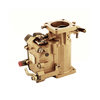I was thinking the other day about how old the GA fleet is getting. The majority of the ~200k GA aircraft in operation were built pre-GARA (peaking in 1978). Next year, those '78 birds will turn 45, which doesn't seem impossible (lots of 50s and 60s planes living their best lives still) but the amount of maintenance, corrosion inspections, etc are only going to creep up and render continued airworthiness economically untenable. This already seem to be a challenge for the light twin fleet, where many of those airframes can fly but are one AD away from being worthless.
So, how much longer does that fleet have left? 2030? 2040? We're not even hitting 3000 new planes a year, so this feels like it'll eventually lead to a contraction of the available fleet unless something changes (a lot more production, which would require a lot more demand, and at current prices a lot more money going into GA).
Thoughts? Am I missing something obvious? Aside from Cirrus, I haven't heard a whisper about anybody ramping up SEP manufacturing. The big party seems to be in biz jets...
So, how much longer does that fleet have left? 2030? 2040? We're not even hitting 3000 new planes a year, so this feels like it'll eventually lead to a contraction of the available fleet unless something changes (a lot more production, which would require a lot more demand, and at current prices a lot more money going into GA).
Thoughts? Am I missing something obvious? Aside from Cirrus, I haven't heard a whisper about anybody ramping up SEP manufacturing. The big party seems to be in biz jets...





